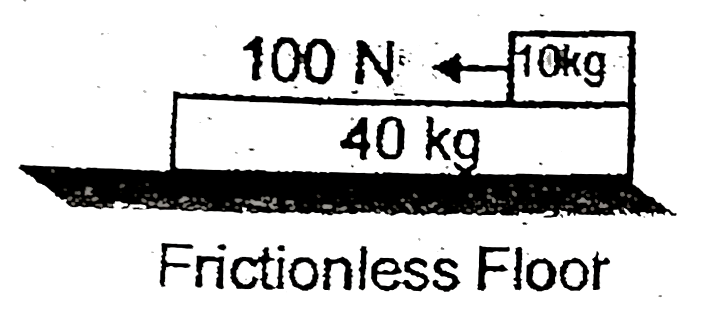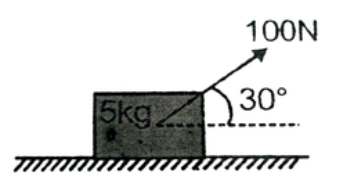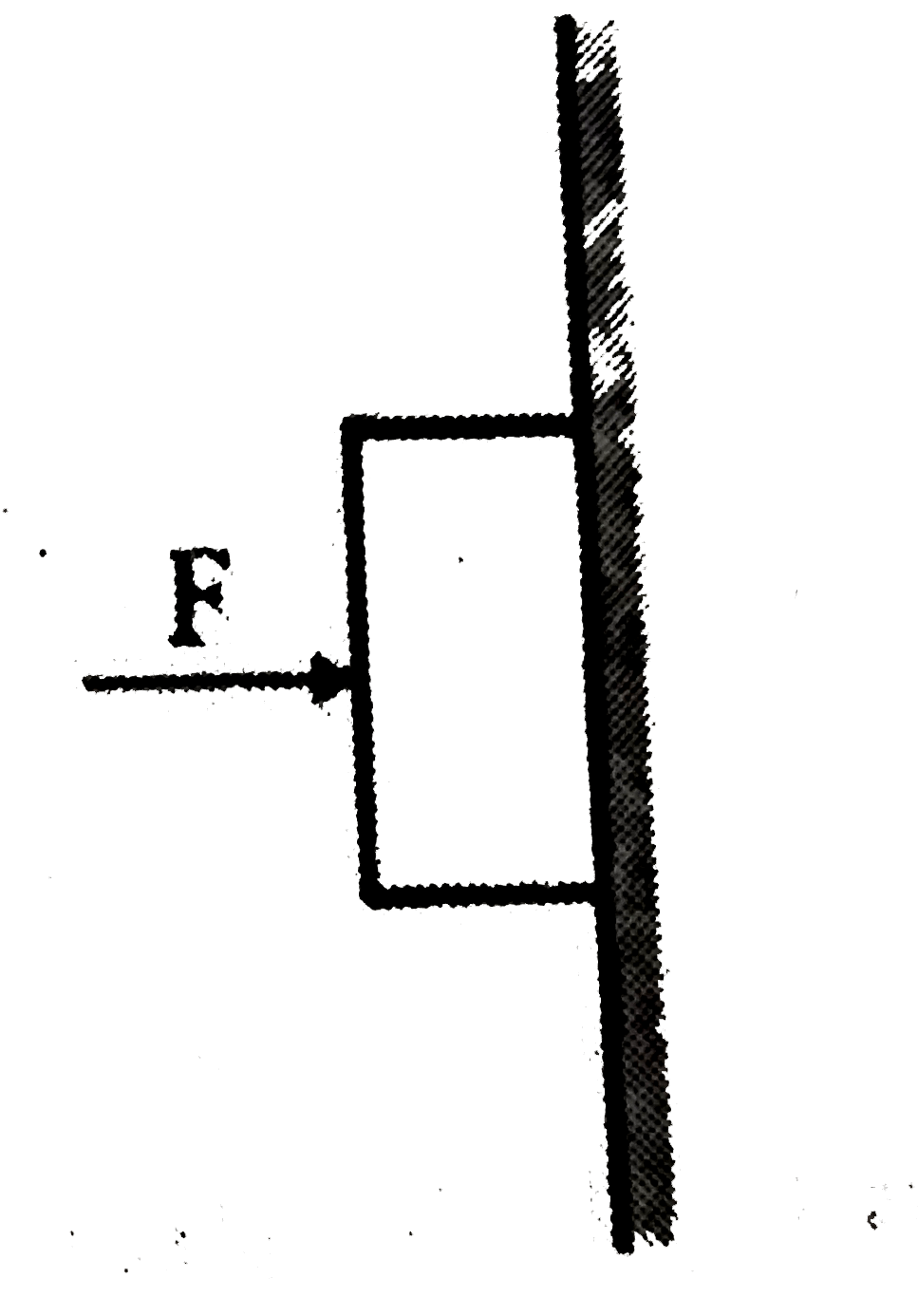A body of mass 60 kg is dragged with just enough force to start moving on a rough surface with coefficient of static and kinetic frictions and respectively . On applying the same force , what is the acceleration ?
The correct Answer is:1
To solve the problem step by step, we will follow the physics principles related to friction and Newton's laws of motion.
Step 1: Identify the forces acting on the body
The body has a mass m=60kg. The forces acting on the body include:
- The gravitational force Fg=mg
- The normal force N
- The static friction force Fs when the body is at rest
- The kinetic friction force Fk when the body is in motion
Step 2: Calculate the gravitational force
The gravitational force can be calculated as:
Fg=mg=60kg×10m/s2=600N
Step 3: Determine the normal force
Since the body is on a horizontal surface and there are no vertical forces acting other than gravity and the normal force, we have:
N=Fg=600N
Step 4: Calculate the maximum static friction force
The maximum static friction force Fsmax can be calculated using the coefficient of static friction μs=0.5:
Fsmax=μs×N=0.5×600N=300N
Step 5: Determine the force applied to start the motion
The force applied to just start moving the body is equal to the maximum static friction force:
F=Fsmax=300N
Step 6: Calculate the kinetic friction force once the body is in motion
Once the body starts moving, we need to consider the kinetic friction force Fk using the coefficient of kinetic friction μk=0.4:
Fk=μk×N=0.4×600N=240N
Step 7: Calculate the net force acting on the body
The net force Fnet acting on the body after it starts moving is the applied force minus the kinetic friction force:
Fnet=F−Fk=300N−240N=60N
Step 8: Calculate the acceleration of the body
Using Newton's second law F=ma, we can find the acceleration a:
a=Fnetm=60N60kg=1m/s2
Final Answer
The acceleration of the body after it starts moving is:
1m/s2
The body has a mass m=60kg. The forces acting on the body include:
- The gravitational force Fg=mg
- The normal force N
- The static friction force Fs when the body is at rest
- The kinetic friction force Fk when the body is in motion
The gravitational force can be calculated as:
Fg=mg=60kg×10m/s2=600N
Since the body is on a horizontal surface and there are no vertical forces acting other than gravity and the normal force, we have:
N=Fg=600N
The maximum static friction force Fsmax can be calculated using the coefficient of static friction μs=0.5:
Fsmax=μs×N=0.5×600N=300N
The force applied to just start moving the body is equal to the maximum static friction force:
F=Fsmax=300N
Once the body starts moving, we need to consider the kinetic friction force Fk using the coefficient of kinetic friction μk=0.4:
Fk=μk×N=0.4×600N=240N
The net force Fnet acting on the body after it starts moving is the applied force minus the kinetic friction force:
Fnet=F−Fk=300N−240N=60N
Using Newton's second law F=ma, we can find the acceleration a:
a=Fnetm=60N60kg=1m/s2
The acceleration of the body after it starts moving is:
1m/s2
Topper's Solved these Questions
- LAWS OF MOTION BOOK - VMC MODULES ENGLISHCHAPTER - LAWS OF MOTION EXERCISE - IMPECCABLE
53 Videos
- LAWS OF MOTION BOOK - VMC MODULES ENGLISHCHAPTER - LAWS OF MOTION EXERCISE - ENABLE
50 Videos
- KINEMATICS OF A PARTICLE BOOK - VMC MODULES ENGLISHCHAPTER - KINEMATICS OF A PARTICLE EXERCISE - JEE Advanced (archive)
14 Videos
- LIQUIDSBOOK - VMC MODULES ENGLISHCHAPTER - LIQUIDSEXERCISE - JEE ADVANCED (LEVEL -2)
55 Videos
Similar Questions
A 60 kg body is pushed with just enough force to start it moving across a floor and the same force continues to act afterwards. The coefficient of static friction and sliding friction are 0.5 and 0.4 respectively. The acceleration of the body is
View SolutionA 60kg is pushed horizontaly with just enough force to start it moving across a floor and the same force continues to act afterwards. The coefficient of static friction and sliding friction are 0.5and 0.4 respectively the accleration of the body is
View SolutionA body of mass 60 kg is pushed up with just enough force to start it moving on a rough surface with μs=0.5 and μk=0.4 and the force continues to act afterwards. What is the acceleration of the body ?
View SolutionA body of weight 64 N is pushed with just enough force to start it moving across a horizontal floor and the same force continues to act afterwards. If the coefficients of static and dynamic friction are 0.6 and 0.4 respectively, the acceleration of the body will be (Acceleration due to gravity = g)
View SolutionA block of mass 5kg is lying on a rough horizontal surface. The coefficient of static and kinetic friction are 0.3 and 0.1 and g=10ms−2 The frictional force on the block is
View SolutionA horizontal force just sufficient to move a body of mass 4kg lying on a rought horizontal surface is applied on it .The coefficient of static and kinetic friction the body and the surface are 0.8and0.6 respectively If the force contines to act even after the block has started moving the acceleration of the block in ms−2 is (g=10ms−2)
View SolutionA slab of 40kg lying on a frictionales floor and a block of 10 kg rests on the slab as shown in the figure. The coefficients of static and kinetic friction between the slab and the block are 0.6 and 0.4 respectively. If a force of 100N is applied on the block, then the acceleration the slab will be (g=10m/s2)

View SolutionA block of mass m is moving on a rough horizontal surface. μ is the coefficient of kinetic friction between the block and the surface. What is the net force exerted by the surface on the block?
View SolutionA block of mass 5 kg is placed on a rough horizontal plane . The coefficients of stastic and kinetic friction between the block and surface are 0⋅5and0⋅3 respectively. A force of 100 N is applied at an angle 30∘ with the horizontal as shown in the figure . The acceleration of the block will be [ g = 10m/s2]

View SolutionA block of mass 1 kg is held at rest against a rough vertical surface by pushing by a force F horizontally. The coefficient of friction is 0.5. When

View Solution
